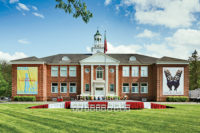MoMA Takes the Bauhaus Back to School

MoMA Takes the Bauhaus Back to School
Erich Consemüller, Untitled (Woman in B3 club chair by Marcel Breuer wearing a mask by Oskar Schlemmer and a dress in fabric designed by Lis Beyer), ca. 1926.
Photo courtesy Estate of Erich Consemüller

MoMA Takes the Bauhaus Back to School
Herbert Bayer, Wall-painting design for the stairwell of the Weimar Bauhaus building on the occasion of the 1923 Bauhaus exhibition, 1923.
Photo courtesy Jim Frank

MoMA Takes the Bauhaus Back to School
Marcel Breuer with textile by Gunta Stölzl, “African” or “Romantic” Chair, 1921.
Photo courtesy Bauhaus-Archiv Berlin / Hartwig Klappert

MoMA Takes the Bauhaus Back to School
Gunta Stölzl, Tapestry, 1922-23.
Photo courtesy Harvard Art Museum / Busch-Reisinger Museum / Michael A. Nedzweski

MoMA Takes the Bauhaus Back to School
Herbert Bayer, Design for a multimedia building, 1924.
Photo courtesy Harvard Art Museum / Busch-Reisinger Museum

MoMA Takes the Bauhaus Back to School
Josef Albers, Set of stacking tables, ca. 1927.
Photo courtesy Albers Foundation / Art Resource, NY / Tim Nighswander

MoMA Takes the Bauhaus Back to School
Herbert Bayer, Design for kiosk and display boards, 1924.
Photo courtesy Katya Kallsen / Harvard College

MoMA Takes the Bauhaus Back to School
Herbert Bayer, Design for an illuminated advertising sphere, 1924.
Photo courtesy Harvard Art Museum / Busch-Reisinger Museum

MoMA Takes the Bauhaus Back to School
Herbert Bayer, Design for a cinema, 1924-25.
Photo courtesy Harvard Art Museum / Busch-Reisinger Museum



















